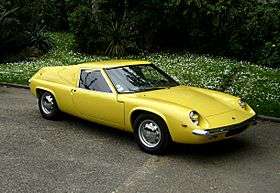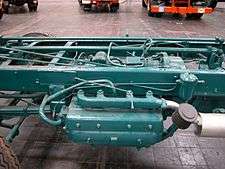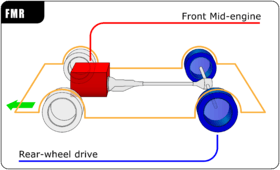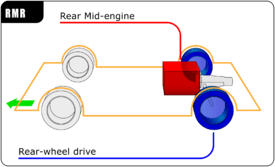Mid-engine design
A mid-engine layout describes the placement of an automobile engine between the rear and front axles.
Benefits

Mounting the engine in the middle instead of the front of the vehicle puts more weight over the rear tires, so they have more traction and provide more assistance to the front tires in braking the vehicle, with less chance of rear-wheel lockup and less chance of a skid or spin out. If the mid-engine vehicle is also rear-drive the added weight on the rear tires can also improve acceleration on slippery surfaces, providing much of the benefit of all wheel drive without the added weight and expense of all wheel drive components. The mid-engine layout makes ABS brakes and traction control systems work better, by providing them more traction to control. The mid-engine layout may make a vehicle safer, since an accident can occur if a vehicle cannot stay in its own lane around a curve or is unable to stop quickly enough. Mid-engine design is also a way to provide additional empty crush space in the front of the automobile between the bumper and the windshield, which can then be used in a frontal collision to absorb more of the impact force to minimize penetration into the passenger compartment of the vehicle.
In most automobiles, and in sports cars especially, ideal car handling requires balanced traction between the front and rear wheels when cornering, in order to maximize the possible speed around curves without sliding out. This balance is harder to achieve when the heavy weight of the engine is located far to the front or far to the rear of the vehicle. Some automobile designs strive to balance the fore and aft weight distribution by other means, such as putting the engine in the front and the transmission and battery in the rear of the vehicle.
Another benefit comes when the heavy mass of the engine is located close to the back of the seats. It makes it easier for the suspension to absorb the force of bumps so the riders feel a smoother ride. But in sports cars the engine position is once again used to increase performance and the potentially smoother ride is usually more than offset by stiffer shock absorbers.
This layout also allows the transmission and motor to be directly bolted to each other—with independent suspension on the driven wheels; this removes the need for the chassis to transfer engine torque reaction.
Drawbacks

The largest drawback of mid-engine cars is restricted rear passenger space; consequently most mid-engine vehicles are two-seat vehicles. The engine in effect pushes the passenger compartment forward towards the front axle (if engine is behind driver). Exceptions typically involve larger vehicles of unusual length or height in which the passengers can share space between the axles with the engine, which can be between them or below them, as in some Toyota vans, large trucks and buses. The mid-engine layout (with a horizontal engine) was common in single-decker buses in the 1950s and 1960s, e.g. the AEC Reliance. The Ferrari Mondial is to date the only successful example of a true mid-engined convertible with seating for 4 and sports car / supercar performance. A version of the Lotus Evora with a removable roof panel is anticipated but no definite date is known.
Like any layout where the engine is not front-mounted and facing the wind, the traditional "engine-behind-the-passengers" layout makes engine cooling more difficult. This has been a problem in some cars, but this issue seems to have been largely solved in newer designs. For example, the Saleen S7 employs large engine-compartment vents on the sides and rear of the bodywork to help dissipate heat from its very high-output engine.
Mid engined cars are more dangerous than front-engined cars if the driver loses control - although this may be initially harder to provoke due to the superior balance - and the car begins to spin. The moment of inertia about the center of gravity is low due to the concentration of mass between the axles (similar to standing in the middle of a playground roundabout, rather than at the edge) and the spin will occur suddenly, the car will rotate faster and it will be harder to recover from. Conversely, a front-engined car is more likely to break away in a progressive and controllable manner as the tires lose traction.
Variations
The term "mid-engine" has usually been applied to cars having the engine located between the driver and the rear drive axles. This layout is referred to here as RMR layout. Sports and racing cars typically have this mid-engine layout, as these vehicles' handling characteristics are more important than other features, such as capacity. Additionally the mechanical layout and packaging of a RMR car is substantially different from that of a front engine or rear engine car.
A subset of Front-Rear when the engine is in front of the driver, but fully behind the front axle line, the layout is sometimes called Front Mid engine Rear FMR layout instead of the less-specific term front-engine. In handling and vehicle layout FMR is substantially the same as FR. Some vehicles could be classified as FR or FMR depending on the factory installed engine (I4 vs I6). Historically most classical FR cars such as the Ford Models T and A would qualify as a FMR engine car. Additionally, the difference between FR and FMR may be as little as a few millimeters of engine protrusion in front of the front axle line as manufacturers mount engine as far back in the chassis as possible. Not all manufacturers use the Front-Mid designation.
Examples
FMR layout – Front Mid-engine / Rear-wheel drive

These cars are RWD cars with engine placed between driver and front axle.
- Alfa Romeo 8C Competizione
- Lotus Elan (first generation)
- Chevrolet Corvette (second through seventh generations)
- Bill Thomas Cheetah (used only one universal joint between transmission tailshaft housing and differential housing)
- Dodge/SRT Viper
- Ferrari 550 Maranello, 575M Maranello, 599 GTB Fiorano, 612 Scaglietti, F12 Berlinetta and GTC4Lusso T
- Honda S2000
- Lexus LFA
- Maserati Quattroporte V, GranTurismo/GranCabrio
- Mazda RX-7, MX-5 and RX-8
- Mercedes-Benz SLR McLaren and SLS AMG
- Opel GT
- Toyota Previa and 2000GT
- Nissan 350Z and Nissan 370Z
- Nissan Skyline
- Porsche 928
- Most pre-World War II front engine rear wheel drive cars.
FM4 layout – Front Mid-engine / Four-wheel drive
This layout, similar to above FMR layout, with engine between driver and behind front axle, adds front wheel drive to become a four-wheel drive.
- Ferrari FF/GTC4Lusso
- Hummer H1
- Toyota Previa All-Trac variant
- Toyota Van 4WD variant (first generation)
RMR layout – Rear Mid-engine / Rear-wheel drive

These cars use traditional engine layout between driver and rear drive axle. Typically, they're simply called MR layout cars.
- Alfa Romeo 4C
- BMW M1 and i8
- Consulier GTP
- DC Avanti
- DeTomaso Vallelunga, Pantera, Guara
- Ferrari Dino 246, 308, 328, 348, Enzo, F355, 360 Modena, F430, FXX, 458 Italia, 488, Mondial, Testarossa, F40, F50, LaFerrari
- Fiat X1/9
- Ford GT and GT40
- Honda Beat and NSX
- Jaguar XJR-15 and XJ220
- Lamborghini Countach, Diablo SV, Jalpa, Silhouette, Gallardo LP550-2
- Lancia Stratos HF, Lancia Montecarlo
- Lotus Europa, Esprit, Elise, Exige, Evora
- Maserati Merak, Bora, Maserati MC12
- Mastretta MXT
- Matra Djet, 530, Bagheera, Murena
- McLaren F1, MP4-12C, 650S, P1
- Mercedes-Benz CLK GTR
- MG F
- Mosler MT900
- Nissan R390 GT1
- Opel Speedster
- Pagani Huayra, Pagani Zonda
- Pontiac Fiero
- Porsche 550, 914, Boxster, Carrera GT, Cayman, Porsche 911 GT1
- Prince R380
- Renault 5 Turbo, Clio V6 Renault Sport
- Ruf 3400S, 3600S & 3800S
- Ruf CTR3
- Ruf RK Coupe/Spyder
- Rumpler Tropfenwagen
- Saleen S7
- SSC Aero
- Toyota MR2/MR-S
- Vauxhall VX220
- Vector WX-8
M4 layout – Rear Mid-engine / Four-wheel drive
These cars uses mid-ship, four-wheel drive, with engine between axles.
- Audi R8
- BMW i8
- Bugatti Veyron, EB110
- Ford RS200
- Honda Acty (4WD versions only), Honda Z (1998-2002)
- Jeep Forward Control
- Lancia Delta S4
- Lamborghini Aventador, Cheetah, Diablo VT series, Gallardo, Murcielago, Reventon, Huracan, Sesto Elemento
- MG Metro 6R4
- Panther Solo 2
- Peugeot 205 Turbo 16
- Volvo L3314, C303
- Porsche 918 Spyder
- Unimog UGN/405
MF layout – Mid-engine / Front-wheel drive

These cars are "mid-ship engined" vehicles, but they use front-wheel drive, with the engine in front of the driver. It is still treated as an FF layout, though, due to the engine's placement still being in the front of the car, contrary to the popular belief that the engine is placed in front of the rear axle with power transferred to the front wheels (an RMF layout). In most examples, the engine is longitudinally mounted rather than the transversely as is common with FF cars.
- Citroën Traction Avant, DS, SM
- Cord 810
- Nissan GT-R LM Nismo
- Renault 4, 5, 16
- Saab Sonett mk1
- Acura Vigor 3rd generation, TL ( only the 2.5 TL )
- Maserati Quattroporte II 1974–1978
- Toyota/Scion iQ, Aston Martin Cygnet